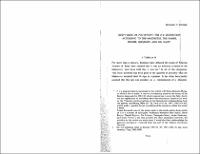Please use this identifier to cite or link to this item:
https://hdl.handle.net/20.500.12202/7130| Title: | Ketiv-Ḳere or Polyphony: The שׂ-שׁ Distinction According to the Masoretes, the Rabbis, Jerome, Qirqisānī, and Hai Gao |
| Authors: | Steiner, Richard Bar-Asher, Moshe |
| Keywords: | ketiv-kere oral text reading tradition |
| Issue Date: | 1996 |
| Publisher: | Bialik Institute, Hebrew University |
| Citation: | Steiner, Richard C. “Ketiv-Ḳere or Polyphony: The שׂ-שׁ Distinction According to the Masoretes, the Rabbis, Jerome, Qirqisānī, and Hai Gaon.” In Studies in Hebrew and Jewish Languages Presented to Shelomo Morag, edited by Moshe Bar-Asher, *151-*179. Jerusalem: Bialik, 1996. |
| Abstract: | The ketiv-kere phenomenon is recorded, albeit only selectively (Yeivin 1980: § § 95,103) in an apparatus (the lists and marginal dotes of the Masorah), but it is not itself an apparatus. It is the set of all discrepancies (including those not noted m the apparatus) between the oral text/reading tradition (milkra') of the Bible and its written text tradition (masoret).53 The kere is rooted in oral tradition, and that is why, already in the first half of the ninth century, it became an issue in sectarian polemics concerning the authority of oral tradition in Judaism. |
| Description: | Scholarly chapter |
| URI: | https://hdl.handle.net/20.500.12202/7130 |
| ISBN: | 9653426591, 9789653426597 |
| Appears in Collections: | Bernard Revel Graduate School of Jewish Studies (BRGS): Faculty Publications |
Files in This Item:
| File | Description | Size | Format | |
|---|---|---|---|---|
| Richard_C_Steiner_Ketiv_ere_or_Polyphon.pdf | 2.07 MB | Adobe PDF |  View/Open |
This item is licensed under a Creative Commons License

